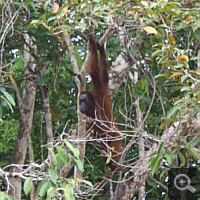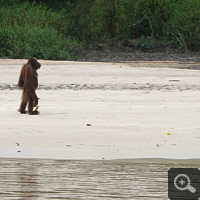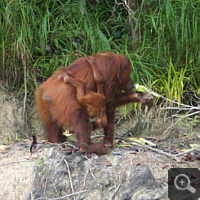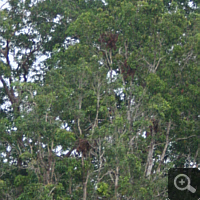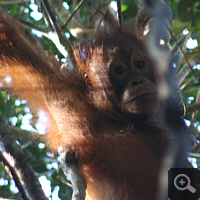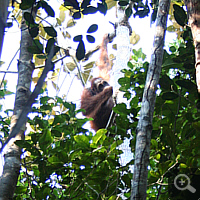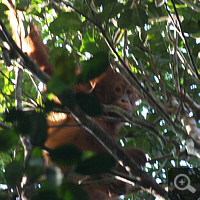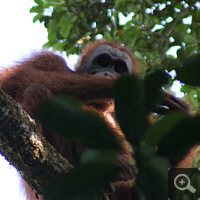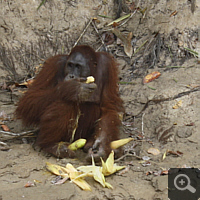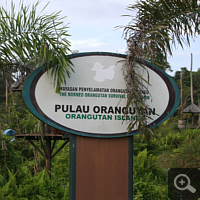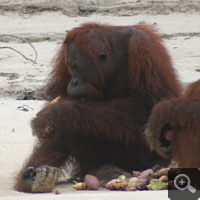Special: Orangutans on Borneo

General remarks & description
Together with human beings, gorillas and chimpanzees orangutans build the family of great apes (Hominidae). The African gorillas and chimpanzees are more closely related with human beings and build together the subfamily Homininae. All three groups originate in Africa and are ground-dwelling. The tree-dwelling, Asian orangutans build on the contrary an own subfamily, the Ponginae.
The name orangutan comes from the Malaysian and means translated forest people. It is composed of the terms orang (human) and utan (forest).
The red haired orangutans are the sole tree-dwelling great apes species. They have a snout-vent length up to 1,50 m. The limbs are strongly adapted to the tree-dwelling living, the arm-to-arm span can total up to 2,25 m.
The solitary living orangutans mostly own a stable territory, young males rather show a migratory behaviour. Orangutans live almost exclusively on vegetarian food, more than the half of the food are fruits. In nature a tool use is only rarely to observe.
Reproduction rate of orangutans is relatively long. After an averaging gestation period of 245 days almost always only one baby comes into the world, twins are extremely rare. After the second year of age the offspring retire gradually from the single mother, it sets to expand its climbing abilities, but it still closely associates with its mother. After the fifth year of age begins final separation form the mother. However, to the end of the eighth year of age more frequent encounters between mother and offspring occur. The mother has anew offspring mostly not until after four to eight years.
The humans are the main enemies of orangutans, natural enemies are Sumatran tigers and crocodiles.
Distribution
Orangutans are only to be found in Indonesia. More precise formulated distribution area spans only Sumatra and Borneo. In the meantime both populations are regarded as different species.
In Sumatra is the Sumatran orangutan (Pongo abelii) native, who only inhabits the northern part of the island. However, in Borneo the Bornean orangutan (Pongo pygmaeus) is native, who is subdivided into three subspecies: Pongo pygmaeus pygmaeus, Pongo pygmaeus morio and Pongo pygmaeus wurmbii. Orangutans are mainly to be found in the southern and eastern part of Borneo.
Orangutans are the sole tree-dwelling great apes species and are only to be found in tropical rainforests up to an elevation of 1.500 m above sea level. Predominantly are swamp rainforest and Dipterocarpaceen-forests (dipterocarp family) inhabited, to which also the genus Shorea belongs. Members of this genus are meranti trees, which as tropical timbers are cutted down and exported.
Endangerment
Orangutans are critically endangered. Thereby the Sumatran orangutan is more endangered than the Bornean orangutan. According to estimations, no more 10.000 orangutans are supposed to live on Sumatra, thus the IUCN rates the species as critically endangered. Estimations of the population numbers of the Bornean orangutan are very divergent and differ from 10.000 to 50.000. The IUCN rates this species as endangered.
The reasons for endangerment of orangutans are multifarious. Destruction of the natural habitat is surely to consider as main factor. To these problems you can find here a detailed consideration. An increasing factor is the gain of areas for palm oil production. Thereby Indonesia plays a prominent role. Meanwhile plam oil is predominantly manufactured into „biofuels“, so that Western industrial nations account mediate for the decrease of orangutans.
Furthermore hunting, illegal trade as well as passing on of diseases play a role.
To a minor degree orangutans are hunted due to their meat, rather hunting takes place in fruit or palm oil plantations, where they are assumed to be a danger or a vermin. Orangutan – babys are still illegally kept as a pet (especially in the Asian region). The wild-caught of orangutan – babys is regular accompanied by killing of the mother.
Because of the close relationship between orangutans and humans and the more and more closely becoming contact, many orangutans are ill with hepatitis or tuberculosis.
Protective measures
Meanwhile several protective measures are existing. In Sumatra most orangutans are living in Gunung Leuser National Park, partially also in Bukit Tigapuluh National Park.
In Borneo, Borneo Orangutan Survival Foundation (BOS) is leading in protection and reintroduction of orangutans into the wild. BOS has several projects, of which we some visited (cf. my travelog).
On the one hand a greater area was reafforested. Meanwhile, in the area Samboja Lestari is a handsome secondary forest located, which accommodates among others hepatitis-infected orangutans.
In Nyaru Menteng – Centre orangutans are fitted for a reintroduction into the wild, thereafter they spend several years on different islands (for example Kaja Island), before they are in elaborate actions returned to the wild in convenient habitats.
In the end of the last century 350 orangutans were returned to the wild by BOS in Southeast Borneo, in the Meratus – region. We also visited this region. But we could not find orangutans in this region.

